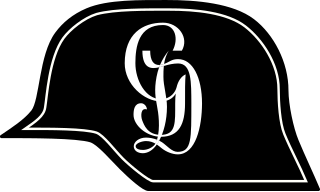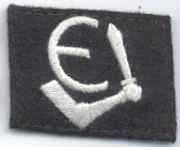Brief history
On 31 October 1944, the 176th Infantry Division was formed out of the 176th Division and was a “training and replacement” formation. It had a strength of about 7,000 men, most of whom were in a poor shape. The division was nicknamed the "kranken division" (sick division), because it was mostly made up of men deemed unfit for military service, such as the physically handicapped and men with severe allergies. One battalion consisted of men with serious hearing maladies, two comprised Luftwaffe personnel, (but with ample infantry training), while many others were convalescents and semi-invalids. [1] In November and December 1944, the Division was part of the XII SS Corps, 5th Panzer Army. Between January and March 1945 the 176th Infantry Division was assigned to the XII SS Corps, 15th Army. The 176th Division was a 'regular' military formation which operated mainly on the Dutch side of the "Roer bridgehead" during Operation Blackcock. During the operation, its HQ was located at Effeld near Vlodrop. The division was actually refitting and re-equipping during the Battle of the Bulge and Operation Blackcock.
The division was assigned to the LXXIV Korps of 15th Army in April 1945 and saw action in the Duisburg area where it eventually surrendered.

The Waffen-SS was the military branch of the Nazi Party's SS organisation. Its formations included men from Nazi Germany, along with volunteers and conscripts from both occupied and unoccupied lands.

The Guards Armoured Division was an armoured division of the British Army during the Second World War. The division was created in the United Kingdom on 17 June 1941 during World War II from elements of the Guards units, the Grenadier Guards, Coldstream Guards, Scots Guards, Irish Guards, Welsh Guards, and the Household Cavalry.

The Panzergrenadier Division "Großdeutschland" was an elite combat unit of the German Army (Heer) that fought on the Eastern Front in World War II.
The Fallschirm-Panzer-Division 1. Hermann Göring was an elite German Luftwaffe armoured division. The HG saw action in North Africa, Sicily, Italy and on the Eastern Front. The division began as a battalion-sized police unit in 1933. Over time it grew into a regiment, brigade, division, and finally was combined with the Parachute-Panzer Division 2 Hermann Göring on May 1, 1944 to form a Panzer corps under the by then Reichsmarschall. It surrendered to the Soviet Army near Dresden on May 8, 1945.
The 21st Panzer Division was a German armoured division best known for its role in the battles of the North African Campaign from 1941–1943 during World War II when it was one of the two armoured divisions making up the Deutsches Afrikakorps (DAK).

The 9th Panzer Division was a panzer division of the Wehrmacht Army during World War II. It came into existence after 4th Light Division was reorganized in January 1940. The division was headquartered in Vienna, in the German military district Wehrkreis XVII.

The 17th SS Panzergrenadier Division "Götz von Berlichingen" was a German Waffen-SS division that saw action on the Western Front during World War II.

The Battle of Narva was a military campaign between the German Army Detachment "Narwa" and the Soviet Leningrad Front fought for possession of the strategically important Narva Isthmus on 2 February – 10 August 1944 during World War II.

The 20th Waffen Grenadier Division of the SS was a foreign infantry division of the Waffen-SS, an armed branch of the German Nazi Party that served alongside but was never formally part of the Wehrmacht during World War II. According to some sources, the division was under Reichsführer-SS Heinrich Himmler's overall command but was not an integral part of the Schutzstaffel (SS). It was officially activated on 24 January 1944, and many of its soldiers had been members of the Estonian Legion and/or the 3rd Estonian SS Volunteer Brigade, which had been fighting as part of German forces since August 1942 and October 1943 respectively. Both of the preceding formations drew their personnel from German-occupied Estonia. Shortly after its official activation, widespread conscription within Estonia was announced by the German occupying authorities. The division was formed in Estonia around a cadre comprising the 3rd Estonian SS Volunteer Brigade, and was initially known as the 20th Estonian SS Volunteer Division.

Fallschirmjäger Regiment Hübner was formed as a reserve unit in August 1944, attached to 7th Parachute Division in September 1944, and operated as an independent Battle Group from November 1944 until March 1945, when it was formally designated Fallschirmjäger Regiment (FJR) 24 and subordinated to the 8th Parachute Division.

The 272nd Infantry Division was a Type 1944 infantry division of the German Wehrmacht during World War II, that was originally formed in December 1943. The division fought in many of the major battles throughout Operation Overlord, culminating in the Retreat from Northern France and the Low Countries in late August/early September 1944.

The 25th Infantry Division was a military unit of the German Wehrmacht. It was later reclassified to 25th Infantry Division (mot.), and in June 1943 to the 25th Panzer Grenadier Division.

The 15th Infantry Division was an infantry division of the German Army during the interwar period and World War II, active from 1934 to 1945.

The 41st Infantry Division, formerly the 41st Fortress Division, was a German Army infantry division in World War II. It was employed on occupation duties in southern Greece, and surrendered to the Yugoslav partisans at the end of the war.

The 376th Infantry Division was an infantry division of the German Army during World War II, active from 1942 to 1944 in two separate instances.
The 549th Volksgrenadier Division was a volksgrenadier infantry division of the German Army during World War II, active from 1944 to 1945. It was formed as the 549th Grenadier Division in July 1944 and became a volksgrenadier division several months later. Fighting on the Eastern Front, it was nearly destroyed in the East Prussian Offensive, with its remnants retreating west and surrendering to American troops at the end of the war.
The 159th Infantry Division was an infantry division of the German Heer during World War II. The unit, at times designated Commander of Reserve Troops IX, 159th Division, Division No. 159, and 159th Reserve Division, was active between 1939 and 1945.
The 180th Infantry Division was an infantry division of the German Heer during World War II. The unit, at times designated Commander of Reserve Troops X/II, 180th Division, Division No. 180, and Operation Division No. 180, was active between 1939 and 1945.
The 182nd Infantry Division was an infantry division of the German Heer during World War II. The unit, at times designated Commander of Reserve Troops XII/II, 182nd Division, Division No. 182, 182nd Replacement Division, Division Nancy,Division Gümbel, Division Karl, and 182nd Reserve Division, was active between 1939 and 1945.
The 252nd Infantry Division was an infantry division of the German Heer during World War II.













